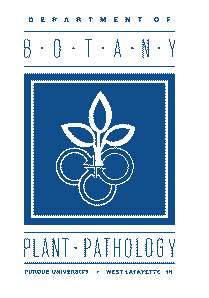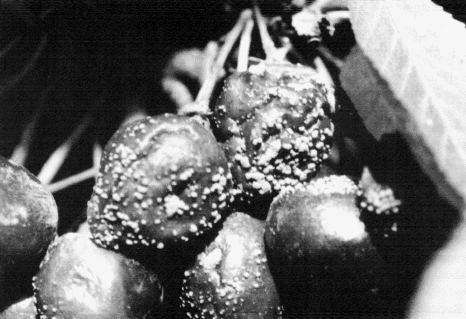
BP-45-W

One of the questions most commonly asked by amateur fruit growers is "Why do my plums and peaches rot and dry up just as they are getting ripe?" The brown rot disease that is responsible for this rot condition will cause some loss every year; and in years when humid, rainy weather occurs, the disease may destroy the entire fruit crop. Brown rot can be just as damaging to cherries, nectarines and other stone fruits.
Brown rot usually first appears during bloom. The blossom clusters wilt and turn brown. If wet weather prevails during bloom the diseased blossom cluster becomes covered with a gray spore mass of the fungus. About two weeks after bloom, the infection will have progressed down the flower stalk into the twigs and branches of the tree. Twigs infected in this way quickly wither causing a die-back of the young terminal shoots. Brown rot on the fruit becomes more noticeable as the fruit approaches maturity.

The first evidence of the rot is the appearance of a small circular brown spot that develops very rapidly if the fruit is mature. The rotted area eventually becomes covered with gray-colored tufts which break through the skin of the fruit. It is this stage that gives the disease the name "Brown Rot". The fruit usually retains its form and remains attached to the tree for some time after it is completely rotted; then it either falls or, if retained on the tree, gradually dries into a firm "mummy".
Brown rot is cause by the fungus, Monilinia fructicola. The fungus overwinters in infected twigs or in mummified fruit on the tree or on the ground. These overwintering sources supply spores for infection in the spring. The blossom clusters and twigs which become infected in spring will then provide a secondary source of spores for fruit infection later in the growing season. There fore, it is important to control these early infections. The disease is most damaging in years when wet weather prevails during bloom and from 3 weeks prior to harvest until harvest.
Brown rot cannot be effectively prevented by one or two sprays or dusts applied in the spring. A combination of both cultural and chemical control measures as outlined below is required for control of brown rot.
Orchard sanitation is of major importance in controlling brown rot. Trees should be pruned to eliminate weak and dead wood, including small twigs that may have been killed by brown rot the year before, and to open them so good spray penetration can be obtained.
Mummied fruit left on the tree after harvest and those on the ground should be removed in early spring and either burned or deeply buried. Rotten fruit that appear in the trees early in the summer should be removed immediately since they are a source of infection for fruit at harvest time.
A fungicide spray program, beginning at bloom and continuing throughout the season is required for those stone fruits highly susceptible to brown rot. Fungicides commonly available to backyard growers for control of brown rot include myclobutanil (sold as Immunox) and captan. Note: Pre-harvest use restrictions and limitations are variable according to product; refer to label for details and always check label for days between final spray and harvest.
For information on recommended fungicides for commercial growers refer to ID-168, "Indiana Commercial Fruit Tree Spray Guide."
References to products in this publication is not intended to be an endorsement to the exclusion of others which may be similar. Persons using such products assume responsibility for their use in accordance with current label directions of the manufacturer.
REVISED 5/01
It is the policy of the Purdue University Cooperative Extension Service, David C. Petritz, Director, that all persons shall have equal opportunity and access to its programs and facilities without regard to race, color, sex, religion, national origin, age, marital status, parental status, sexual orientation, or disability.
Purdue University is an Affirmative Action employer.
This material may be available in alternative formats.
1-888-EXT-INFO
http://www. extension.purdue.edu/extmedia